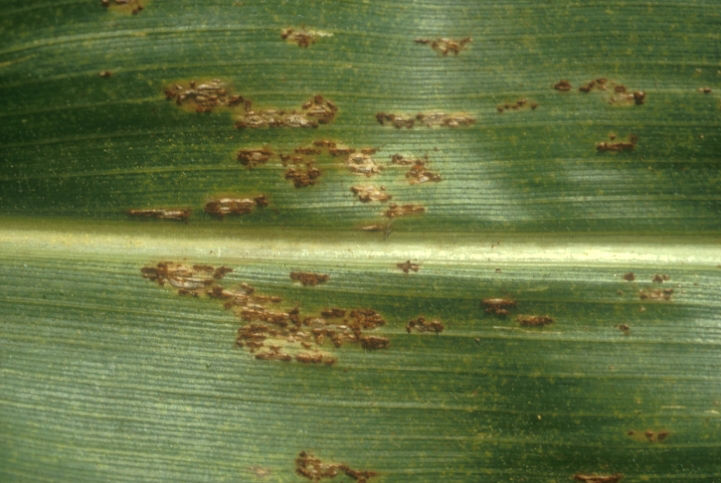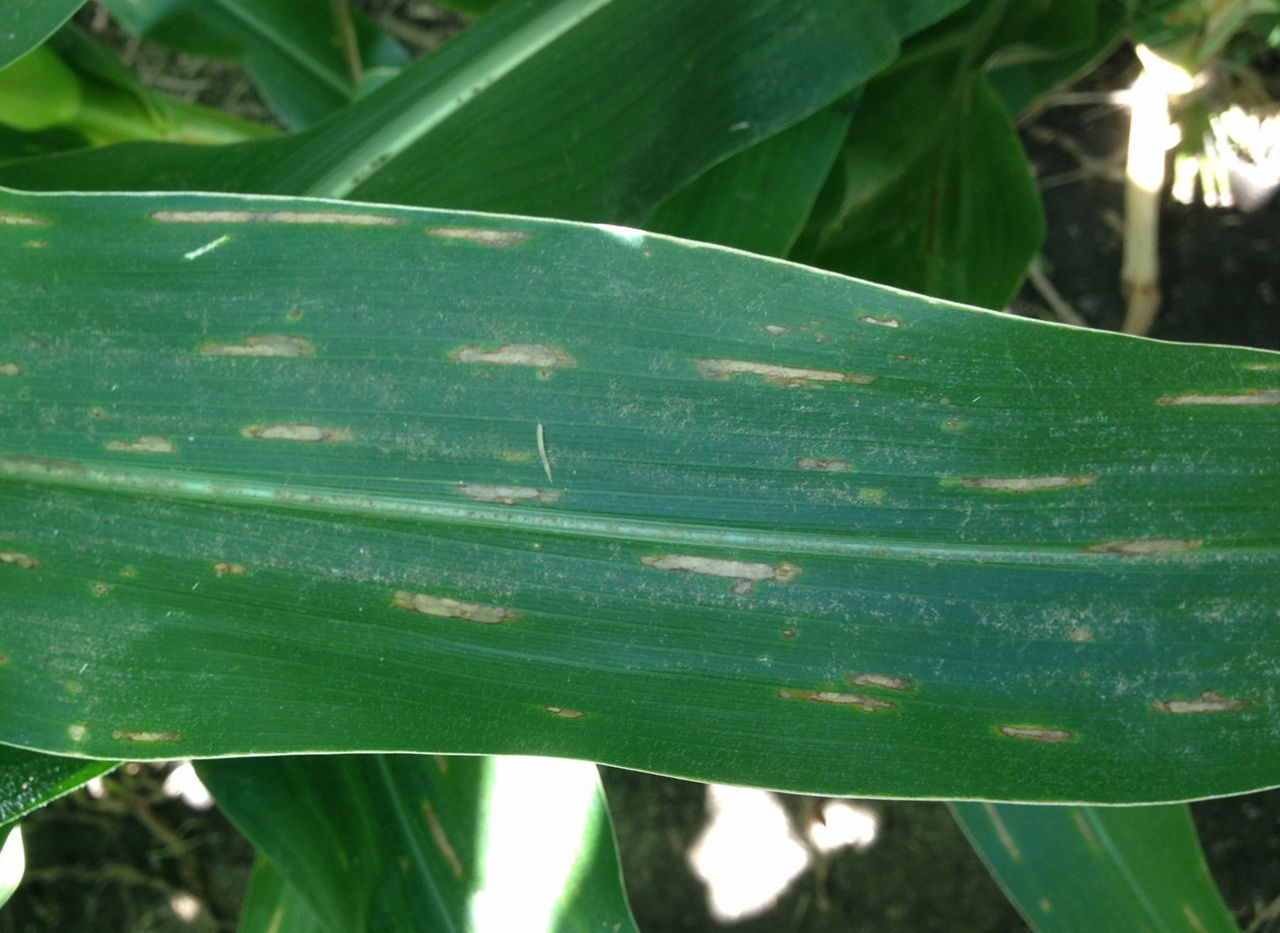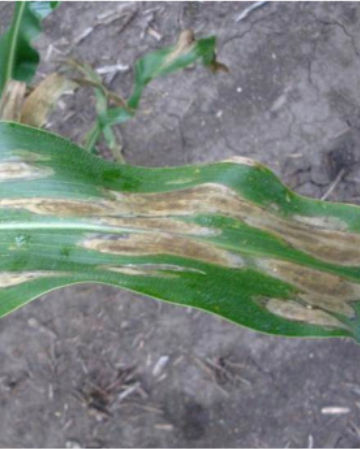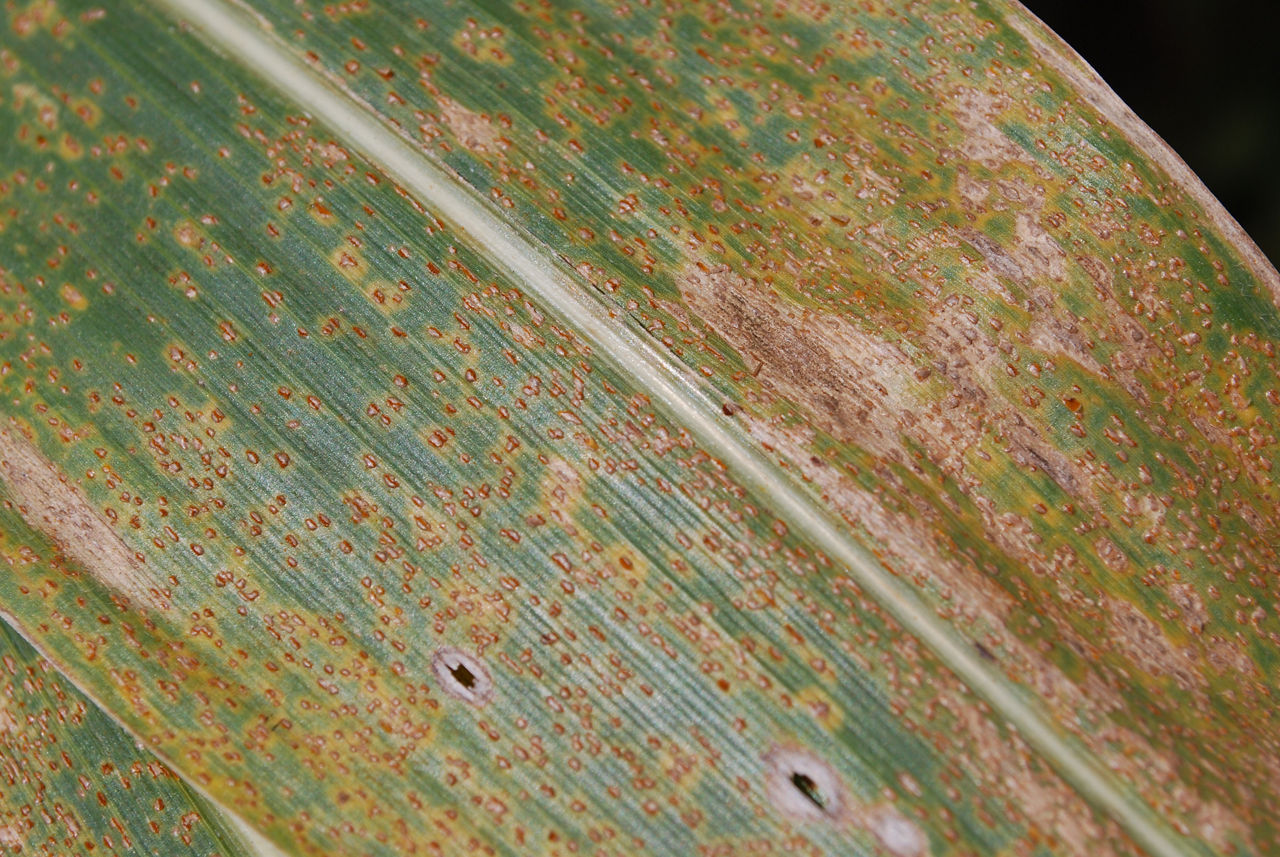Late Season Corn Diseases Identification
September 14, 2023
- Utilizing the correct management tactics for corn diseases depends on proper identification of the disease, the severity of the infection, and the anticipated spread of the disease.
- The information below can help identify late-season foliar, stalk, and ear diseases of corn and their management tactics.
- While some of these foliar diseases can occur during the early season and mid-season window, they occur most often in the late season, from tasseling to black layer.
Click on late season disease tab to learn more
Diagnostic Characteristics: Common rust is a fungal disease, and its early symptom is chlorotic flecks appearing on the leaf surface. These flecks soon develop into powdery, brick-red pustules. Pustules are oval or elongated, about 1/8 inch (3 mm) long, and scattered sparsely or clustered together. The leaf tissue around the pustules may become yellow or die, leaving lesions of dead tissue. As the pustules age, the red spores turn black, making the pustules appear black.
Scouting Window: Typically, two weeks prior to pollination and throughout grain fill. Pustule formation can occur when common rust development is favored by high humidity with night temperatures of 65 to 70 °F (18 to 21 °C) and moderate daytime temperatures. The disease is usually more severe on seed corn.
Management:
In-season: Common rust rarely reaches levels that cause yield loss in commercial corn products. However, there are fungicides available to treat common rust. Applications of these fungicides are most beneficial on susceptible corn products, especially if applied early when few pustules have appeared on the leaves.
Off season: A selection of corn products with excellent tolerance to common rust is available.

Diagnostic Characteristics: Small (less than ¼ inch), circular, translucent lesions surrounded by a yellow to purple margin. Lesions may coalesce and form a larger lesion. In severe infections, the entire leaf may die. Lesions are surrounded by a yellow halo visible when a leaf is held up to light. Lower leaves are usually infected first. Eyespot development is favored by cool and humid weather.
Scouting Window: Typically, two weeks prior to pollination and throughout grain fill. Pustule formation can occur earlier under ideal disease conditions, especially in late-planted corn. Infection before flowering causes the most risk of yield loss.
Management:
In-season: Usually, fungicides are not needed for this disease in late season.
Off season: Select corn products with excellent tolerance and utilize crop rotation.

Diagnostic Characteristics: Gray leaf spot is a fungal disease that causes small, necrotic spots with halos, which become rectangular blocks running parallel to leaf veins.
Scouting Window: Typically, two weeks prior to and two weeks after pollination. GLS has a 2-week incubation period after infection.
Management:
In-season: Fungicide application at VT to R1, or earlier, if lesions appear earlier in the season.
Off season: Selecting corn products with good (or improved) GLS ratings is important in fields with a history of GLS pressure. Crop rotation may also be effective.

Diagnostic Characteristics: Northern corn leaf blight is a fungal disease that causes lesions that are long (1 to 6 inches, 2.5 to 15 cm) and elliptical, which appear gray green at first but then turn pale gray or tan. Under moist conditions, dark gray spores are produced, usually on the lower leaf surface, which give lesions a "dirty" gray appearance.
Scouting Window: Typically, two weeks prior to and two weeks after pollination.
Management:
In-season: Fungicide application at VT to R1, or earlier, if lesions appear earlier in season.
Off season: Select corn products with good NCLB ratings for fields with a history of NCLB pressure. Crop rotation may also be effective.

Diagnostic Characteristics: Northern leaf spot, also known as Helminthosporium leaf spot or Carbonum leaf spot, is occasionally found in the lower canopy during periods of high humidity and moderate temperatures. There are five known races, with races 2 and 3 being the most common in the Midwest. Race 2 is associated with oblong, somewhat rectangular, brown spots (¼ to ½ by 1 inch, 6 to 13 by 25 mm) on leaves and black mold on kernels. While race 3 causes long, narrow, light tan lesions (up to 1 inch, 25 mm) that are surrounded by a darker border on leaves, sheaths, and husks.
Resistant hybrids and inbreds are available. Crop rotation and tillage reduce inoculum survival. Foliar fungicides labeled for northern corn leaf spot are available.
Scouting Window: Silking to full maturity.
Management:
In-season: Corn products resistant to all races of northern leaf spot are available, and this is usually not an important disease in hybrid corn.
Off season: Use crop rotation and residue management to reduce inoculum.

Diagnostic Characteristics: Southern rust is a fungal disease that produces circular to oval spots with light green to yellow halos. Orange to red pustules develop on leaf surfaces. Southern rust infection can result from storms that move up from the south followed by wet and humid weather.
Scouting Window: Typically, two weeks prior to pollination and throughout grain fill. Pustule formation can occur earlier under ideal conditions, especially in late-planted corn. Infection before flowering causes the most risk of yield loss.
Management:
In-season: Foliar fungicides may be effective when applied soon after the first few pustules are observed. Multiple applications may be needed in severely infected fields, though fungicide application applied within two weeks of black layer is unlikely to provide any economic return. The fungicide should contain dual modes of action, including a strobilurin (Trifloxystrobin) and triazole (Prothioconazole).
Off season: Selecting corn products with excellent tolerance to southern rust is important in areas at high risk for severe disease outbreaks. In some geographies, early planting dates minimize the window in July during which storms can carry the fungus from the south, temperatures are high, and conditions are humid.

Diagnostic Characteristics: Tar spot is a fungal disease that infects corn leaves, husks, and stalks, and creates black spots called stroma. Tar spot lesions are hard, black, raised spots that are typically 1/16 to 3/4 inch (0.15 to 2 cm) in diameter that cannot be rubbed off. Dew, lingering fogs, and rainy days extend leaf wetness duration which drives disease severity.
Scouting Window: Typically, tar spot has been observed most often during mid- to late grain fill (growth stages R3 to R6). However, the disease has been observed shortly before pollination.
Management:
In-season: Apply foliar fungicide at VT/R1 and continue to scout throughout grainfill. If disease severity continues to increase, consider an additional fungicide application. While there is an application that can be predict tar spot, Tarspotter (https://ipcm.wisc.edu/apps/tarspotter/), note there are still some issues with the application. The application does not consider previous history of the disease in the field, and if the disease was present in the previous year, the field would be at a higher risk. The application uses weather data, but the stations may not be close enough to provide the necessary precision.
Off season: While reducing residue is a common practice in crop disease management and it may help reduce inoculum, the results of using tillage to management tar spot have been inconsistent. Rotate to other crops and avoid highly susceptible corn products.

Sources
Corn diseases: Symptoms, scouting, and management. Iowa State University Extension and Outreach. https://crops.extension.iastate.edu/corn-diseases-symptoms-scouting-and-management
Woloshuk, C. and Wise, K. Aspergillus ear rot. Purdue University Extension. Diseases of corn. BP-83-W. https://www.extension.purdue.edu/extmedia/BP/BP-83-W.pdf
Bergstrom, G., et al. 2019. An overview of southern rust. Crop Protection Network. CPN-2009. https://cropprotectionnetwork.org/publications/an-overview-of-southern-rust
1211_145184
Seed Brands & Traits
Crop Protection
Disclaimer
Always read and follow pesticide label directions, insect resistance management requirements (where applicable), and grain marketing and all other stewardship practices.
©2024 Bayer Group. All rights reserved.